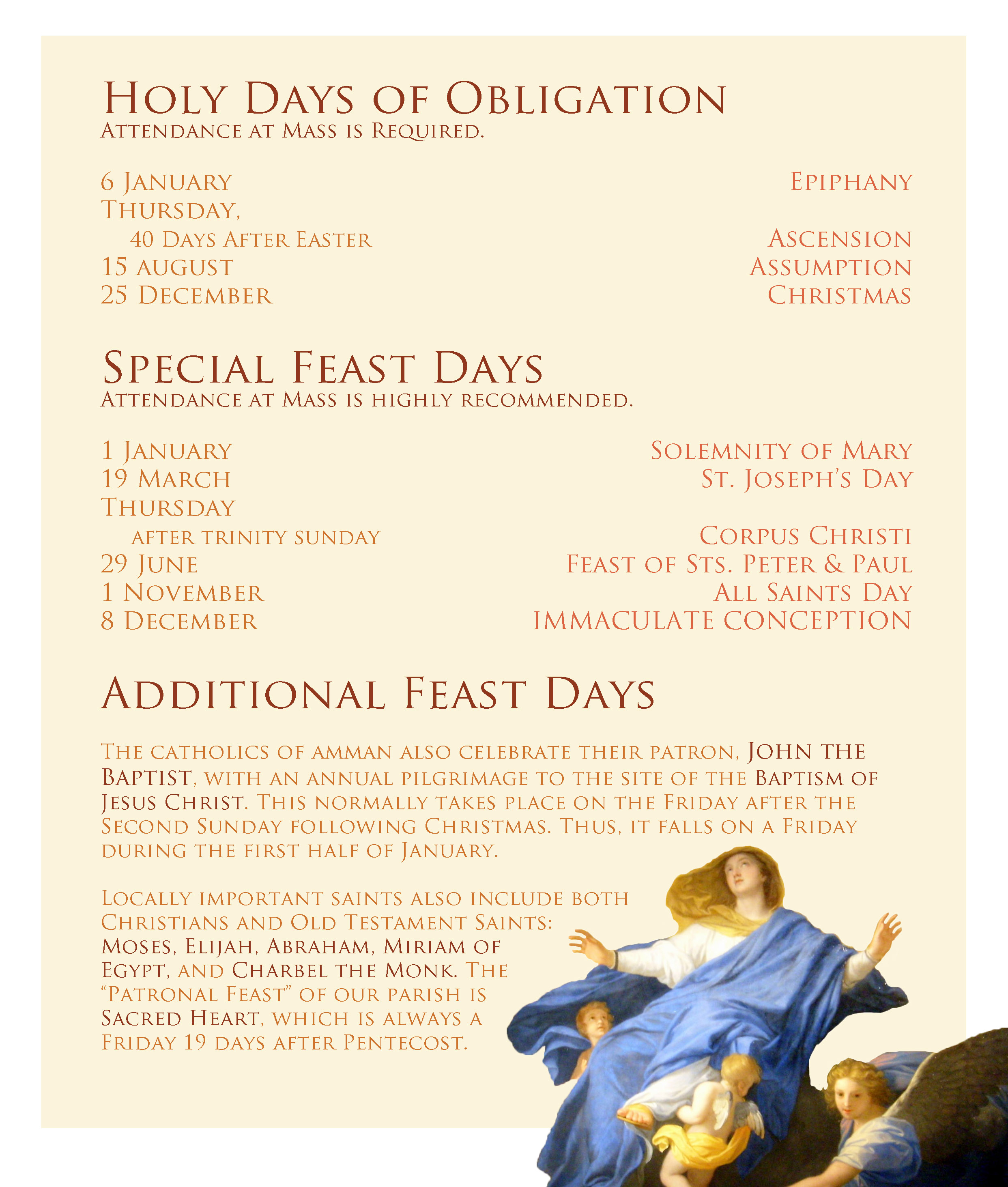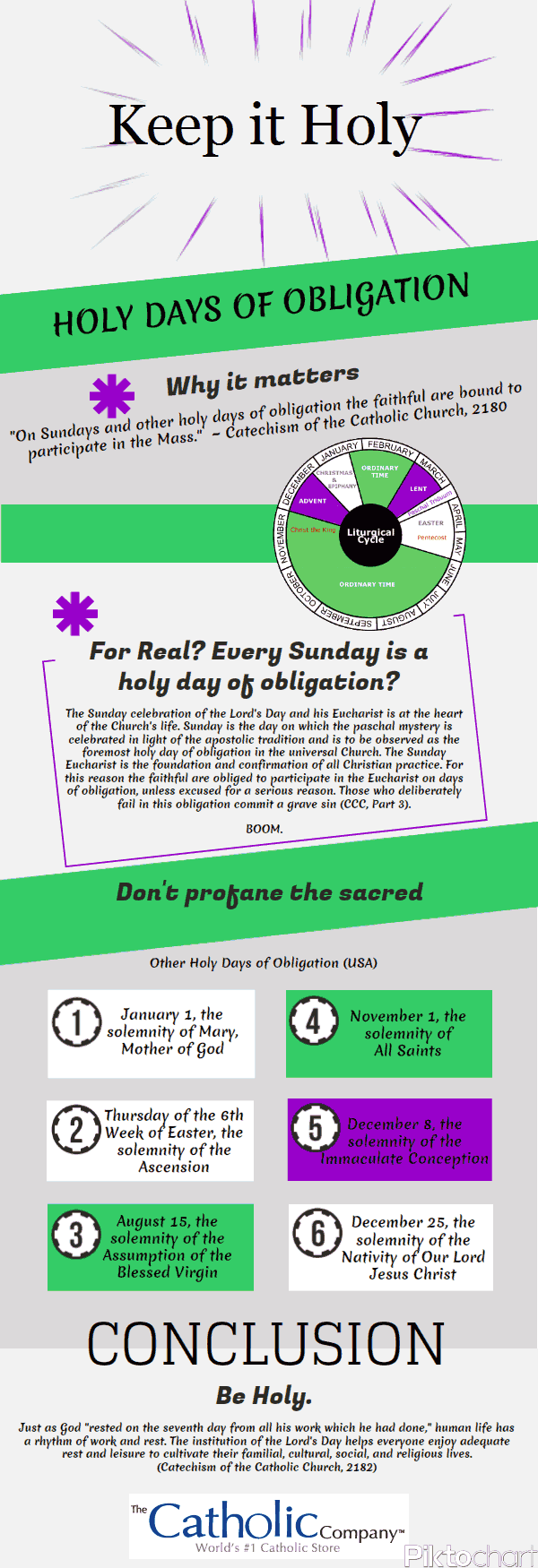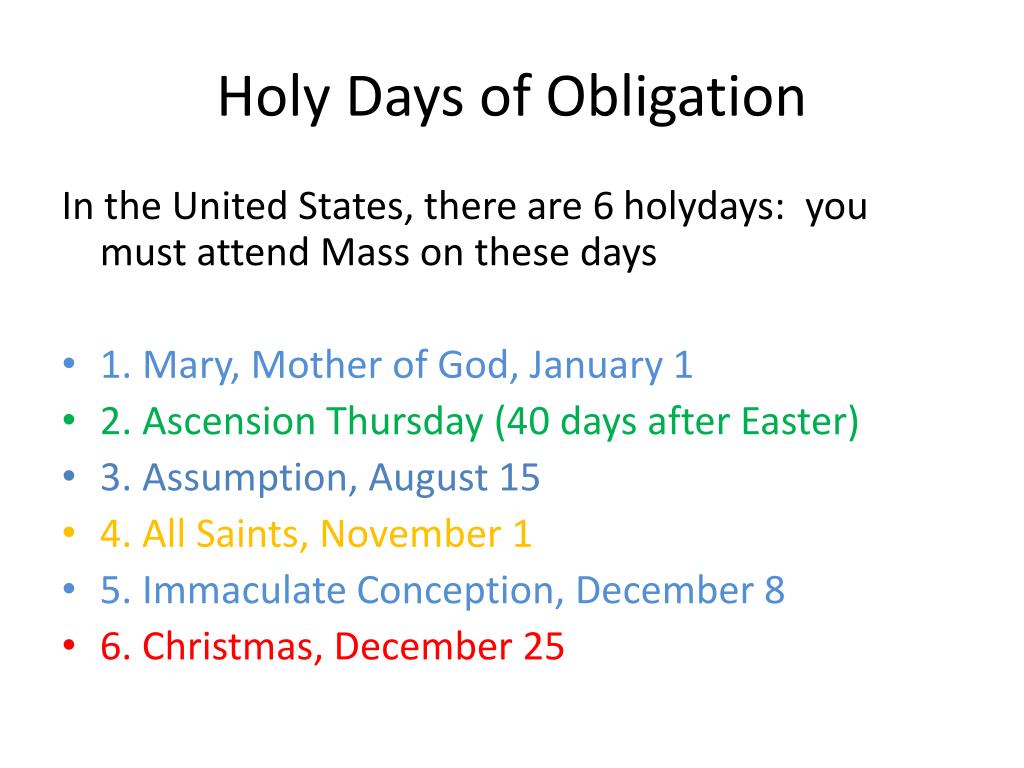Understanding Holy Days of Obligation in the United States: A Comprehensive Guide for 2025
Related Articles: Understanding Holy Days of Obligation in the United States: A Comprehensive Guide for 2025
Introduction
With great pleasure, we will explore the intriguing topic related to Understanding Holy Days of Obligation in the United States: A Comprehensive Guide for 2025. Let’s weave interesting information and offer fresh perspectives to the readers.
Table of Content
Understanding Holy Days of Obligation in the United States: A Comprehensive Guide for 2025

The Catholic Church designates specific days throughout the year as "Holy Days of Obligation," emphasizing their significance for the faithful. These days are set aside for special prayer, reflection, and participation in Mass, serving as a reminder of pivotal events in the life of Christ and the Church.
In the United States, the United States Conference of Catholic Bishops (USCCB) outlines the Holy Days of Obligation for the following year. This article will provide a comprehensive overview of these days for 2025, focusing on their importance and offering practical guidance for observance.
Holy Days of Obligation in 2025
For the year 2025, the following dates are designated as Holy Days of Obligation in the United States:
-
Mary, Mother of God (January 1): This day celebrates the Blessed Virgin Mary, the mother of Jesus, and her pivotal role in the salvation of humanity. It commemorates the beginning of the New Year and the Church’s year, emphasizing the importance of Mary’s intercession and maternal role.
-
The Ascension of the Lord (May 29): This day celebrates the ascension of Jesus Christ into heaven forty days after his resurrection. It signifies the triumph of Christ over death and his reign in glory at the right hand of God the Father.
-
The Assumption of the Blessed Virgin Mary (August 15): This day celebrates the bodily assumption of the Blessed Virgin Mary into heaven. It acknowledges the unique role of Mary in the Church and her ultimate victory over death.
-
All Saints Day (November 1): This day honors all the saints, known and unknown, who have gone before us. It serves as a reminder of the communion of saints and the ultimate destiny of all believers.
-
The Immaculate Conception of the Blessed Virgin Mary (December 8): This day celebrates the conception of the Blessed Virgin Mary without original sin. It highlights Mary’s special grace and her role as the Mother of God.
-
Christmas Day (December 25): This day celebrates the birth of Jesus Christ, the Son of God, and the incarnation of the Word. It is the most significant feast of the Christian year, marking the beginning of the Christian era.
The Importance of Holy Days of Obligation
Observing Holy Days of Obligation is a fundamental aspect of Catholic life. These days hold a special significance within the Church’s liturgical year, offering opportunities for:
-
Deepening Faith: Holy Days of Obligation provide a structured framework for reflecting on the mysteries of faith, deepening our understanding of God’s work in our lives.
-
Strengthening Community: Participating in Mass on these days fosters a sense of unity and belonging within the Catholic community, bringing the faithful together in prayer and shared worship.
-
Honoring Sacred Events: Observing these days honors the pivotal events in the life of Christ and the Church, reminding us of the central tenets of our faith.
-
Cultivating Gratitude: Holy Days of Obligation provide opportunities to express gratitude for God’s blessings and to acknowledge the transformative power of faith in our lives.
Observing Holy Days of Obligation
The primary way to observe Holy Days of Obligation is by attending Mass. While the obligation applies to those who are physically able, it is essential to remember that attending Mass is a privilege and a source of grace.
For those who cannot attend Mass due to illness or other circumstances, spiritual communion is a valuable alternative. This involves uniting oneself spiritually with the sacrifice of the Mass, offering prayers and reflections on the day’s significance.
FAQs about Holy Days of Obligation
Q: What happens if I miss a Holy Day of Obligation?
A: Missing a Holy Day of Obligation is a serious matter, as it signifies a neglect of one’s duty to the Church. However, it is not a sin in itself. Instead, it is a grave matter that requires seeking reconciliation with God through confession.
Q: Can I attend Mass on a different day if I miss the Holy Day of Obligation?
A: While attending Mass on a different day can be a good practice, it does not fulfill the obligation to attend Mass on the designated Holy Day.
Q: What if I am traveling on a Holy Day of Obligation?
A: If you are traveling on a Holy Day of Obligation, you are still obligated to attend Mass. If possible, try to plan your travel around the obligation to attend Mass on the designated day.
Q: Are there any exceptions to attending Mass on Holy Days of Obligation?
A: There are some exceptions to the obligation to attend Mass on Holy Days of Obligation, such as serious illness, caring for a sick person, or other compelling reasons. These exceptions should be evaluated on a case-by-case basis, and it is recommended to consult with a priest or spiritual director for guidance.
Tips for Observing Holy Days of Obligation
-
Plan Ahead: Mark the Holy Days of Obligation on your calendar and make arrangements to attend Mass.
-
Attend Mass with Intention: Approach Mass with a spirit of reverence and prayer, actively participating in the liturgy.
-
Reflect on the Day’s Significance: Take time to reflect on the meaning of the Holy Day and its connection to your personal life.
-
Share the Faith: Encourage others to participate in Holy Days of Obligation and share the importance of these days with them.
Conclusion
Holy Days of Obligation provide opportunities for the faithful to deepen their relationship with God, strengthen their connection with the Church, and celebrate the pivotal events that shaped Christian history. By embracing these days with reverence and intention, we can enrich our spiritual lives and draw closer to the Lord.








Closure
Thus, we hope this article has provided valuable insights into Understanding Holy Days of Obligation in the United States: A Comprehensive Guide for 2025. We thank you for taking the time to read this article. See you in our next article!